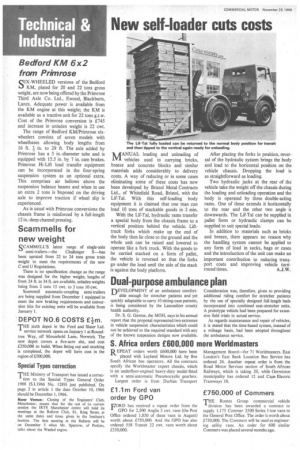New self-loader cuts costs
Page 42

If you've noticed an error in this article please click here to report it so we can fix it.
MANUAL loading and unloading of vehicles used in carrying bricks, breeze and concrete blocks and similar materials adds considerably to delivery costs. A way of reducing or in some cases eliminating some of these costs has now been developed by Bristol Metal Contracts Ltd., of Whitefield Road, Bristol, with the Lif-Tal. With this self-loading body equipment it is claimed that one man can load 10 tons of stackable goods in 2 min. With the Lif-Tal, hydraulic rams transfer a special body from the chassis frame to a vertical position behind the vehicle. Lifttruck forks which make up the end of the body then lie close to the ground and the whole unit can be raised and lowered to operate like a fork truck. With the goods to be carried stacked on a form of pallet, the vehicle is reversed so that the forks go under the load until the side of the stack is against the body platform. After placing the forks in position, reversal of the hydraulic system brings the body and load to the horizontal position on the vehicle chassis. Dropping the load is as straightforward as loading. Two hydraulic jacks at the rear of the vehicle take the weight off the chassis during the loading and unloading operation and the body is operated by three double-acting rams. One of these extends it horizontally to the rear and the other two angle it downwards. The Lif-Tal can be supplied in pallet form or hydraulic clamps can be supplied to suit special loads. In addition to materials such as bricks and breeze, there appears no reason why the handling system cannot be applied to any form of load in sacks, bags or cases and the introduction of the unit can make an important contribution to reducing transport costs and improving vehicle turn
round times. A.J.W.












































































































